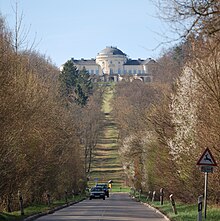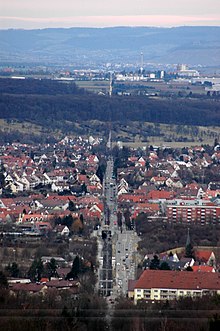Baseline Solitude-Allee

The Solitude-Allee , laid out in 1768 as a connecting axis between Solitude Palace and Ludwigsburg , served from 1820 as the base line for the Württemberg state survey .
course
Today, Solitude-Allee leads steeply down the slope as an unpaved path from the north gate of the Solitude Castle, which is located on the Keuperstufe , and joins the Bergheimer Steige at its foot . From the Weilimdorfer district Bergheim it is called Solitudestrasse and retains this name through the district Wolfbusch and the center of Weilimdorf up to the border of the Korntal . From here your street name is Solitudeallee . At Stuttgart-Neuwirtshaus, it crosses the former Römerstraße and today's Bundesstraße 10 at a right angle, leads over Lange Feld to Stuttgart-Stammheim , along the Stammheim JVA to Kornwestheim and from here as an asphalt dirt road to Ludwigsburg , where the construction of the Württemberg road began in 1844 " Nordbahn " from Stuttgart to Heilbronn was interrupted.
history
Avenue for duke and court
Duke Carl Eugen had the Solitude Avenue from 1764 to 1768 as a direct connection axis from the Ludwigsburg Palace of Schloss Solitude build and to reserve for the royal household. The common people were prohibited from entering the street under penalty of punishment. The road, which is useless in terms of traffic geography, was a symbol of absolutist arbitrariness, before it was at least useful for land surveying.
Basis for the national survey
On May 25, 1818, King Wilhelm I ordered the first land survey in the Kingdom of Württemberg by decree to the Ministry of Finance. On September 18, 1820, the natural scientist Johann Gottlieb Friedrich von Bohnenberger , who was appointed to lead the project, began surveying Solitude-Allee in the presence of "His Majesty", which he had chosen as the main base for triangulation because of its straight lines . The starting point of the baseline was in the center of Solitude Castle, where a memorial plaque is now attached (see illustration). At the end point in front of the then city limits of Ludwigsburg, Bohnenberger had a wooden pyramid built, from which one had the necessary view. At its former location, at the confluence of Köhlstrasse and Solitude-Allee, there is now a memorial stone with the inscription "Württemberg Land Survey 1820 - Solitude-Ludwigsburg base - length 13032.14 m - end point in the street axis". The determined base length of 40,118.718 Paris feet (1 Paris foot = 0.32484 meters) was compared with the Bavarian base line near Munich . The difference was only 0.182 Paris feet (0.059 m).
Measurement methods and tools
In the Württemberg yearbook of 1822, Bohnenberger explained why you need a straight and precisely measured baseline in order to be able to carry out the state survey on this basis. If one thinks from the endpoints of this base line as straight lines to a third point, one only has to measure the angles of the triangle "with the great perfection of the Reichenbach protractors with an accuracy that exceeds that of the direct measurement ..." in order to derive the to be able to calculate both lines precisely. The prerequisite is that you can see the other two from each point. Each of these precisely calculated lines is now again the base line for another triangle, so that finally the entire country to be measured is covered by a " trigonometric network ". The sine law can be used to calculate the missing sides of the triangle.
Karl Koch from the Land Surveying Office Baden-Württemberg, who presented the original diary presumably from the pen of the surveying commissioner Major von Gasser, described the approach of the surveyors :
- “The basic measuring apparatus was made by the mechanic Butzengeiger in Tübingen ... The apparatus consisted of five iron measuring rods, a measuring wedge, a level with a degree curve, a measuring bridge and a lace . The measuring rods were each 12 Parisian feet (approx. 3.9 m) long, 16 kg in weight, calibrated to 13 ° Réaumur and clad with wood so that only the ends of the iron rods protruded. Each measuring rod was provided with a thermometer ... The measurement was not carried out in the horizontal position of the rods; rather, the inclination was determined by means of a level with a degree arc and taken into account in the measurement result. The measurement itself was not carried out on the premises, but on a measuring bridge, which consisted of six wooden trestles, each approx. 85 cm high and 85 cm wide ... On September 18, 1820 the basic measuring device was brought from Tübingen to Solitude Castle ... Sappers provided by the military were used to set up the measurement bridge, to dismantle it and to transport the trestles, as well as to carry poles, etc. "
Every day of the work was recorded in the diary; as an example, the entry from October 11, 1820:
- “The measurement started with the 611th position. At lunchtime, Sr. Königl. Majesty the measurement, while Sr. Majesty lingered for a long time, showed the manipulation, and they stayed at the 630th position of the 5th pole and marked a stake with a point. In the evening the measurement with the 647th position of the 5th rod was decided. "
Garden of Triangulation
As a compensatory measure for the space-intensive construction of their new container transshipment station, Deutsche Bahn AG had a triangulation garden designed by the Baden-Württemberg State Surveyor's Office laid out in 1998 . On the area west of the train station on Solitude-Allee, part of the historical triangular network of the national survey carried out from 1818 to 1840 is reproduced in a scale model.
The Solitude-Allee as the baseline of the first triangle is emphasized in the model by a bench. Stone pillars mark the corner points of the main triangular network. The rock types of the pillars correspond to the geology of the respective location. Railroad tracks embedded in the floor trace the sight lines between the corner points.
See also
- Baseline Unterföhring – Aufkirchen (1801)
- Gaussian land survey , with reference to the triangulation (directed by Gauß himself) from 1821 to 1825
- Base Bonn (1847)
- Grossenhainer baseline (1870)
literature
- Johann Gottlieb Friedrich von Bohnenberger : About the measurement of the main base between Solitude and Ludwigsburg for the purposes of the national survey . In: Württembergisches Jahrbuch von 1822.
- Alfred Egerer: The mathematical foundations of the Württemberg maps. In: Württemberg year books for statistics and regional studies. 1930/31, ISSN 0721-1589 , pp. 287-420.
- Bernhard Klar and Erika Porten: The Solitudeallee in Weilimdorf, a cultural monument of land surveying from 1820 . In: Weilimdorfer Heimatblatt , number 24, June 2002, 2nd edition May 2007, published by Weilimdorfer Heimatkreis eV Digitalisat (PDF)
- Land survey office Baden-Württemberg (publisher): 150 years of Württemberg land surveying. Stuttgart 1968.
- Baden-Württemberg Ministry of Economic Affairs: 175 years of Württemberg land surveying . Stuttgart 1993.
Individual evidence
- ↑ Bernhard Klar and Erika Porten: The Solitudeallee in Weilimdorf, a cultural monument of the land survey from 1820 . In: Weilimdorfer Heimatblatt , number 24, June 2002, 2nd edition May 2007, p. 2, published by Weilimdorfer Heimatkreis eV WHB 24 as PDF
- ↑ For the location of the starting point, see 48 ° 47 ′ 12.8 ″ N , 9 ° 5 ′ 3.5 ″ E
- ↑ For the location of the end point, see 48 ° 53 ′ 2.8 ″ N , 9 ° 10 ′ 59.9 ″ E
- ↑ Johann Gottlieb Friedrich von Bohnenberger : About the measurement of the main base between Solitude and Ludwigsburg for the purpose of land surveying . In: Württembergisches Jahrbuch von 1822.
- ↑ Title: The diary about the measurement of the Württemberg main base from Schloss Solitude to Ludwigsburg
- ↑ SWR film on the base measurement in 1820 in Württemberg (April 1999) SWR school television
- ↑ For the location of the Garden of Triangulation see 48 ° 51 ′ 42.8 ″ N , 9 ° 9 ′ 37.4 ″ E
- ↑ Bernhard Klar and Erika Porten: The Solitudeallee in Weilimdorf, a cultural monument of the land survey from 1820 . In: Weilimdorfer Heimatblatt , number 24, June 2002, 2nd edition May 2007, p. 4f, published by Weilimdorfer Heimatkreis eV WHB 24 as PDF
Web links
Coordinates: 48 ° 50 ' N , 9 ° 8' E



